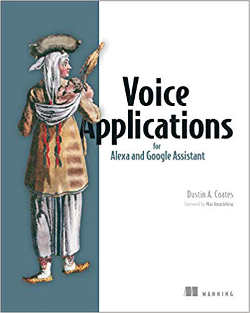| Voice Applications |
Author: Dustin A. Coates Alexa and Google Assistant are making voice interaction increasingly prevalent. Want to join in creating apps for them? When reviewing the state of voice interaction we often compare three alternatives - Alexa, the Google Assistant and Siri. Here however only the first two are covered - this is because Apple excludes third party developers from developing for Siri. Even though Amazon and Google have produced and documented SDKs for working with their voice-activated devices there's not a lot that has made it into print about them. This makes this book a welcome resource. I found it especially reassuring that the author has co-existed with both Alexa and Google Home and has shared the, sometimes frustrating, experience of learning to live with voice interaction. It's now getting better partly due to changes of behavior on the part of human users as well as through the efforts of software developers. The book uses JavaScript and Node.js for building applications for both Alexa and Google Assistant and has plenty of code throughout. It comprises twelve chapters, four on voice UIs in general, four on Alexa and four on Google Assistant with hands-on projects introduced throughout. The first chapter presents an overview of how and where we've got to with voice UIs. It introduces NLP - natural language processing - and looks at what goes on in a conversation before moving on to technicalities of constructing voice commands. Then in the second chapter you dive straight into building a call-and-response skill on Alexa. The next three chapters are also devoted to Alexa - designing a voice user interface, using entity resolution and built-in intents in Alexa skills and making a conversational Alexa skill, which is, of course, the goal of the Alexa Prize, which we've followed since its inception.
The next three chapters go deeper into what is required for a convincing, more human-like conversation and how to direct the flow of conversation through the use of questions. Again the technical practicalities - response and request interceptors, discourse markers, slot configuration and so on are presented in well annotated code. The final four chapters focus on Google Assistant. The first of them looks at how Google Assistant differs from other platforms and explains the differences between the Actions SKK and Dialogflow before building an interaction model in Dialogflow and creating a Dialogflow-powered action. The next, with the title "Going multimodal" extends voice applications beyond voice - specifically to Google's surface capabilities.Push interactions are the topic of the penultimate chapter and the last one is "Building for actions on Google with the Actions SDK". This book is not only strong on design for voice UI, it's also strong on implementation. If you want to build voice apps, it's a mine of useful tips and best practices grounded in clear explanations and well annotated code.
To keep up with our coverage of books for programmers, follow @bookwatchiprog on Twitter or subscribe to I Programmer's Books RSS feed for each day's new addition to Book Watch and for new reviews.
|
|||
| Last Updated ( Saturday, 03 October 2020 ) |


